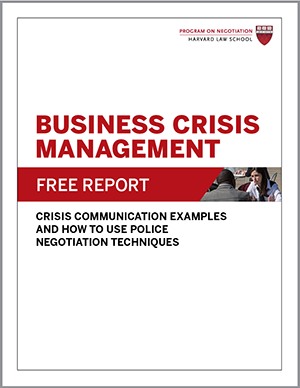
Many actions that could help alleviate the Covid-19 pandemic require us to change our behavior on a personal level, such as staying home from work and wearing a mask in public places. Others, such as making coronavirus-related research more widely available, require more organizational and systemic change.
But humans often resist change; we are negotiating change within ourselves every day, because it’s in our nature to stick with the more comfortable and familiar status quo. Moreover, broad changes across groups with different motives and perspectives can be complicated by conflict.
Negotiation principles and change models may be able to help parties not just navigate the changes required by the crisis, but set the stage for a recovery that will leave us stronger, said Harvard Medical School professor Kimberlyn Leary and Brandeis University professor Joel Cutcher-Gershenfeld during a March 22 online talk hosted by the Program on Negotiation at Harvard Law School.
Negotiating Change: 3 Challenges that Require Change
“We’ve been living some version of negotiated change for some time,” Leary noted. “Now it’s that much more accelerated.” She and Cutcher-Gershenfeld focused on three specific public-health initiatives that require a coordinated approach:
- Instituting physical distancing in society with the goal of slowing the spread of the coronavirus to protect the healthcare system’s ability to care for patients. While most people have adapted to such changes, some have protested stay-at-home orders.
- Surging the production of personal protective equipment (PPE) and medical devices, such as face shields and ventilators. At 2,000 so-called “fab labs,” or digital fabrication labs across the globe, hobbyists and others who have never made medical supplies are contributing to the production of personal protective equipment (PPE) and medical devices.
- Increasing the free and open sharing of scientific data to facilitate research aimed at finding coronavirus treatments and therapies. Researchers, publishers, and other data gatekeepers are being called on to open up their data and models to help hasten the end of the pandemic.
Negotiating Change: 3 Principles from Negotiation Theory
These three negotiation principles may be especially helpful in efforts to negotiate solutions to the pandemic, according to Leary and Cutcher-Gershenfeld:
- Focus on interests. Interest-based bargaining, which involves exploring the deeper interests underlying negotiators’ stated positions, can help parties identify potential tradeoffs and opportunities for joint gains.
- Anticipate and address sources of bias. Under the best of conditions, we are all prone to predictable biases and other cognitive errors. For instance, in-group bias can keep us from allocating resources, such as face masks, equitably across groups.
- Reach agreement within and across parties. For every agreement we reach, a host of other agreements is often needed. Crisis negotiations often require multilateral bargaining.
Negotiating Change: 3 Change-Management Models
Several models from the realm of change management can be applied to problems posed by Covid-19:
- Top-down change. In his top-down model of change, Harvard Business School professor John Kotter described a person in an authority role who drives change by enlisting people in a shared vision and empowering them to spread change. In Kotter’s model, the goal is to move from the current state of affairs to a desired end state.
- Bottom-up change. The second model of change, an outgrowth of a Ford Motor Company executive leadership program and psychiatrist Elizabeth Kübler-Ross’s five-stage model of grief, acknowledges that people pass through a series of stages before accepting significant change. Shock is followed by denial, awareness that change is necessary, acceptance of reality, experimentation and testing of new approaches and skills, understanding, and finally by the integration of new skills and behavior into a new way of operating.
- Middle-across change. In this model from WayMark Analytics and the Stakeholder Alignment Collaborative, the various parties to a complex change effort maintain their separate identities while working together to negotiate issues of common interest. Middle-across change can help identify stakeholders and their interests, and bring them together.
Putting It All Together
The three challenges identified can all benefit from the application of negotiation principles and change-management models, according to Leary and Cutcher-Gershenfeld:
- Physical distancing: Change-management models may be particularly helpful in ensuring people are getting the food and supplies they need. In the food services industry, where change occurs within a hierarchy, top-down styles leavened with elements of negotiation may be effective in driving processes to understand changes to the core business. Meanwhile, as we see protestors testing stay-at-home orders, it may be helpful to consider that some may still be at the shock and denial stages, focused more on the economic impact of the virus than on its threat to their health.
- Surging production of PPE and equipment: In this realm, all three change models are coming into play. Ford, GM, and other manufacturers are transforming themselves from the top down. At fab labs, scientists and fabricators are moving at an accelerated pace, while government officials struggle to regulate their efforts and at times issue cease-and-desist orders on their efforts, leading to the need for interest-based negotiations among stakeholders.
- Open sharing of data: Data centers are relying on top-down models to prepare for a massive increase in the amount and diversity of information being shared, as well as the diversity of users. Prompted by the crisis, some are beginning to share what used to be viewed as proprietary, while others refuse to do so. Stakeholders will need to negotiate laterally to determine how intellectual property is used during and after the pandemic.
By agreeing on negotiation principles and change processes, we can improve the odds of mutual gains, said Leary and Cutcher-Gershenfeld. To view their talk, including audience questions and preliminary answers, visit the Program on Negotiation’s YouTube channel.




